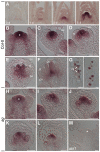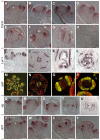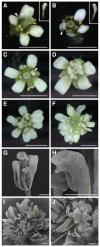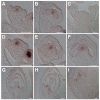On reconciling the interactions between APETALA2, miR172 and AGAMOUS with the ABC model of flower development
- PMID: 20876650
- PMCID: PMC2964095
- DOI: 10.1242/dev.036673
On reconciling the interactions between APETALA2, miR172 and AGAMOUS with the ABC model of flower development
Abstract
The ABC model of flower development explains how three classes of homeotic genes confer identity to the four types of floral organs. In Arabidopsis thaliana, APETALA2 (AP2) and AGAMOUS (AG) represent A- and C-class genes that act in an antagonistic fashion to specify perianth and reproductive organs, respectively. An apparent paradox was the finding that AP2 mRNA is supposedly uniformly distributed throughout young floral primordia. Although miR172 has a role in preventing AP2 protein accumulation, miR172 was reported to disappear from the periphery only several days after AG activation in the center of the flower. Here, we resolve the enigmatic behavior of AP2 and its negative regulator miR172 through careful expression analyses. We find that AP2 mRNA accumulates predominantly in the outer floral whorls, as expected for an A-class homeotic gene. Its pattern overlaps only transiently with that of miR172, which we find to be restricted to the center of young floral primordia from early stages on. MiR172 also accumulates in the shoot meristem upon floral induction, compatible with its known role in regulating AP2-related genes with a role in flowering. Furthermore, we show that AP2 can cause striking organ proliferation defects that are not limited to the center of the floral meristem, where its antagonist AG is required for terminating stem cell proliferation. Moreover, AP2 never expands uniformly into the center of ag mutant flowers, while miR172 is largely unaffected by loss of AG activity. We present a model in which the decision whether stamens or petals develop is based on the balance between AP2 and AG activities, rather than the two being mutually exclusive.
Figures







Similar articles
-
The miR172 target TOE3 represses AGAMOUS expression during Arabidopsis floral patterning.Plant Sci. 2014 Feb;215-216:29-38. doi: 10.1016/j.plantsci.2013.10.010. Epub 2013 Oct 25. Plant Sci. 2014. PMID: 24388512
-
miR172 regulates stem cell fate and defines the inner boundary of APETALA3 and PISTILLATA expression domain in Arabidopsis floral meristems.Plant J. 2007 Sep;51(5):840-9. doi: 10.1111/j.1365-313X.2007.03181.x. Epub 2007 Jun 15. Plant J. 2007. PMID: 17573799 Free PMC article.
-
Floral patterning defects induced by Arabidopsis APETALA2 and microRNA172 expression in Nicotiana benthamiana.Plant Mol Biol. 2006 Jul;61(4-5):781-93. doi: 10.1007/s11103-006-0049-0. Plant Mol Biol. 2006. PMID: 16897492 Free PMC article.
-
Floral stem cells: from dynamic balance towards termination.Biochem Soc Trans. 2010 Apr;38(2):613-6. doi: 10.1042/BST0380613. Biochem Soc Trans. 2010. PMID: 20298230 Review.
-
Regulation of flowering time and floral patterning by miR172.J Exp Bot. 2011 Jan;62(2):487-95. doi: 10.1093/jxb/erq295. Epub 2010 Oct 15. J Exp Bot. 2011. PMID: 20952628 Review.
Cited by
-
Arabidopsis RNA-binding protein FCA regulates microRNA172 processing in thermosensory flowering.J Biol Chem. 2012 May 4;287(19):16007-16. doi: 10.1074/jbc.M111.337485. Epub 2012 Mar 19. J Biol Chem. 2012. PMID: 22431732 Free PMC article.
-
Regulation of reproductive development by non-coding RNA in Arabidopsis: to flower or not to flower.J Plant Res. 2012 Nov;125(6):693-704. doi: 10.1007/s10265-012-0513-7. Epub 2012 Jul 27. J Plant Res. 2012. PMID: 22836383 Free PMC article. Review.
-
How to Evolve a Perianth: A Review of Cadastral Mechanisms for Perianth Identity.Front Plant Sci. 2018 Oct 29;9:1573. doi: 10.3389/fpls.2018.01573. eCollection 2018. Front Plant Sci. 2018. PMID: 30420867 Free PMC article. Review.
-
Whole-transcriptome analysis of differentially expressed genes between ray and disc florets and identification of flowering regulatory genes in Chrysanthemum morifolium.Front Plant Sci. 2022 Aug 4;13:947331. doi: 10.3389/fpls.2022.947331. eCollection 2022. Front Plant Sci. 2022. PMID: 35991433 Free PMC article.
-
HISTONE DEACETYLASE 19 and the flowering time gene FD maintain reproductive meristem identity in an age-dependent manner.J Exp Bot. 2018 Sep 14;69(20):4757-4771. doi: 10.1093/jxb/ery239. J Exp Bot. 2018. PMID: 29945158 Free PMC article.
References
-
- Alonso J. M., Stepanova A. N., Leisse T. J., Kim C. J., Chen H., Shinn P., Stevenson D. K., Zimmerman J., Barajas P., Cheuk R., et al. (2003). Genome-wide insertional mutagenesis of Arabidopsis thaliana. Science 301, 653-657 - PubMed
-
- Alvarez-Venegas R., Pien S., Sadder M., Witmer X., Grossniklaus U., Avramova Z. (2003). ATX-1, an Arabidopsis homolog of trithorax, activates flower homeotic genes. Curr. Biol. 13, 627-637 - PubMed
-
- Bensmihen S., To A., Lambert G., Kroj T., Giraudat J., Parcy F. (2004). Analysis of an activated ABI5 allele using a new selection method for transgenic Arabidopsis seeds. FEBS Lett. 561, 127-131 - PubMed
-
- Bomblies K., Dagenais N., Weigel D. (1999). Redundant enhancers mediate transcriptional repression of AGAMOUS by APETALA2. Dev. Biol. 216, 260-264 - PubMed
Publication types
MeSH terms
Substances
Grants and funding
LinkOut - more resources
Full Text Sources
Other Literature Sources
Molecular Biology Databases
Research Materials

